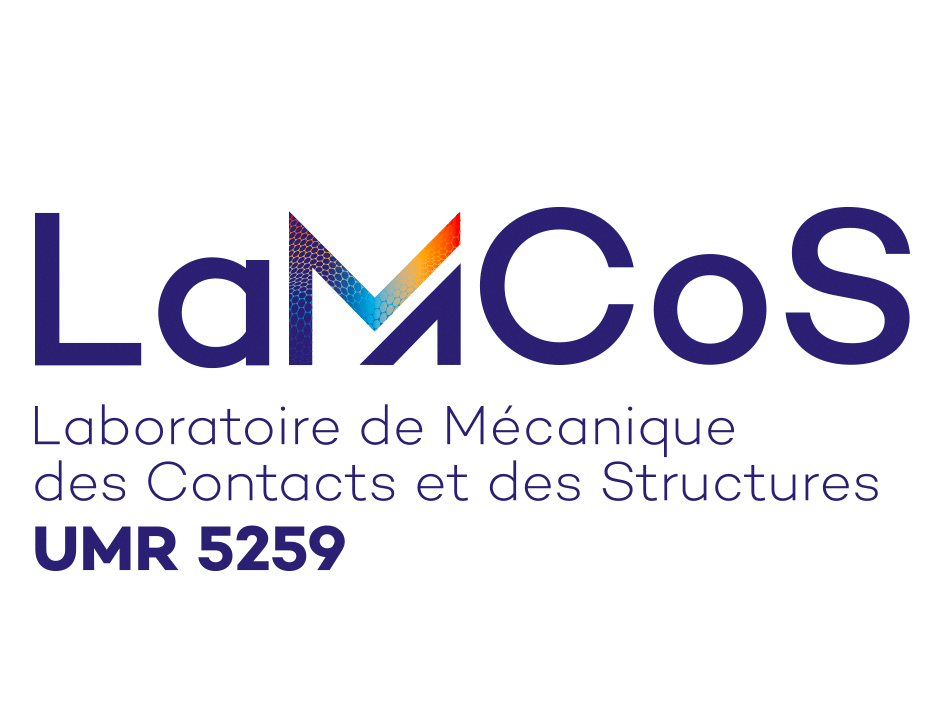Presentation
The biomechanics platform of the LaMCoS, UMR5259 INSA Lyon CNRS, offers expertise and assistance in the field of biomechanical assessment of biological tissues and various medical devices for the public and private scientific community. of biological tissues and various medical devices from the public and private scientific community. It is open to all types of collaborative or contractual biomechanical projects.
Different types of services are available :
- Advice and support in setting up biomechanics projects
- Theoretical and practical training in biomechanics
- Carrying out mechanical tests on different types of biological or biomimetic tissue/structures and at different drynesses (from lubricant to hard tissue); in various physiological and pathophysiological contexts; correlation with in silico predictions
- Assessment of friction and wear mechanisms in medical devices
- Collection and analysis of material degradation particles (e.g. wear particles)
- Assessment of mechanobiological interactions between tissues (tissues from animal or human clinical protocols) or cells (cell lines or primary cultures) at the tissue/implant interface
- Synthesis of different types of biomimetic lubricants based on lipids
- Technology watch
Skills
- Design and adaptation of experimental simulators for characterising different types of biological tissue/structures
or biomimetic structures

- Mechanical characterisation of different types of biological or biomimetic tissue/structures .
- Bio-tribological characterisation of different types of joint implants

- Characterisation of implant wear after various simulator tests and explants (volumetric wear of bodies in contact, surface condition, analysis of wear particles in lubricants, analysis of pro-inflammatory lipid markers in lubricants) .
- Analysis of wear particles generated by various medical devices and study of their biological impact
in situ (in periprotein tissue following clinical protocols

and/or during bio-tribological tests) - Optimisation of the biological tissue/implant interface by optimising the mechano-biological reaction at this interface using bio-tribo-reactors

- Synthesis of biomimetic lubricants from synovial fluid .
Equipment
-
4 L2 rooms and one ISO5 room available for the preparation of biological tissues and for in vitro tests
They are equipped with PSMs, incubators, centrifuges, autoclaves, drills, saws, microtome, light microscopy), biomechanical tests on living tissue, particle extraction and sorting.
Existing cell lines: SH-SY5Y neuroblastomas, RAW macrophages
Primary human cultures from existing clinical protocols: chondrocytes, synoviocytes
Additional techniques are also available, such as fluorescence microscopy, UV-visible spectroscopy, electrophoresis and histochemistry.
More specific tools can be used to assess the mechanical properties of materials or bio-systems (ex-vito, in vitro or model systems) and their interaction ...
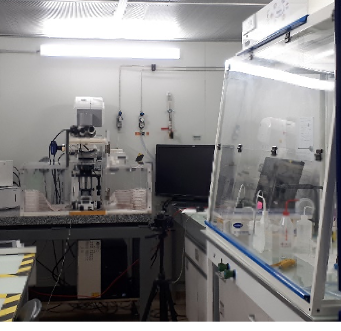
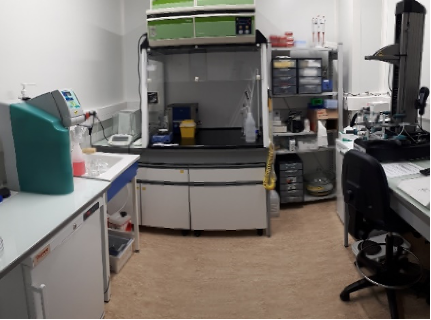
The ISO5 room has been equipped for the bio-tribological expertise of explants thanks to the ERDF/Region/CNRS project: Bio-tribo-mineralogy
- Traction machine
-
ARES rheometer
Controlled deformation rheometer
SMT technology (separate motor and transducer)
Torque measurement range: 0.02 to 2000 g - cm
Normal force measurement range: 2 to 2000 gmf
Maximum operating frequency: 100 rad/s
Available geometries: parallel plates in stainless steel or glass (50 mm), cone and plate; possibility of total sample immersion
Possible test modes :- Dynamic test methods (e.g. strain sweep, frequency sweep, time sweep)
- Stable and transient test methods (e.g. speed sweep, stress relaxation, thixotropic loop)
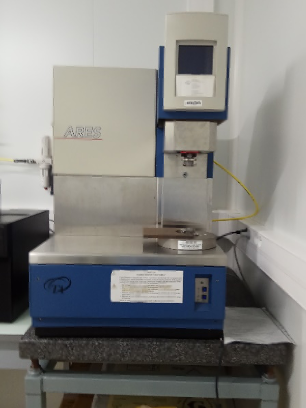
-
Zeiss Axio microscope with confocal head type LSM700
Microscope configuration allowing visualisation of a rubbing contact (compatible with the bio-tribometer below) or of cells (tissues) subjected to mechanical stress (compatible with the bio-reactor below) using conventional optical microscopy, fluorescence and/or confocal microscopy. (tissues) subjected to mechanical stress (compatible with bio-reactor below) using conventional optical microscopy, fluorescence and/or confocal microscopy.
In its current configuration, the user has excitation at 405 nm, 488 nm, 555 nm or 639 nm and Zeiss ZEN software equipped with the specific modules required for :- FRAP (Fluorescence Recovery after Photobleaching)
- FRET (Förster resonance energy transfer)
- RICM (Reflection inteference contrast microscopy)
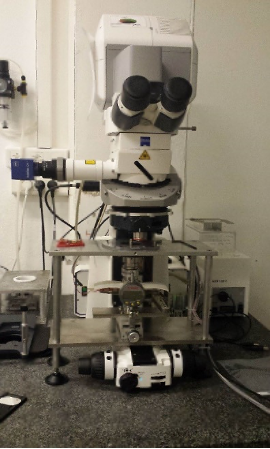
- Micropipette system
-
System for collecting and analysing airborne particles on biomimetic surfactant
This portable system has a 4-hour battery life and includes
- 1) Air collection (particles and gases) on biomimetic surfactant and real-time measurements of oxidative stress (marker of an inflammatory process) and alveolar rigidity (marker of a degenerative pathological process). oxidative stress (marker of an inflammatory process) and alveolar rigidity (marker of a degenerative pathological process)
- 2) A section for real-time measurements of atmospheric parameters (pressure, temperature, humidity, gas concentration, particle counter)
- 3) Particle collection on supports compatible with SEM-EDX analysis
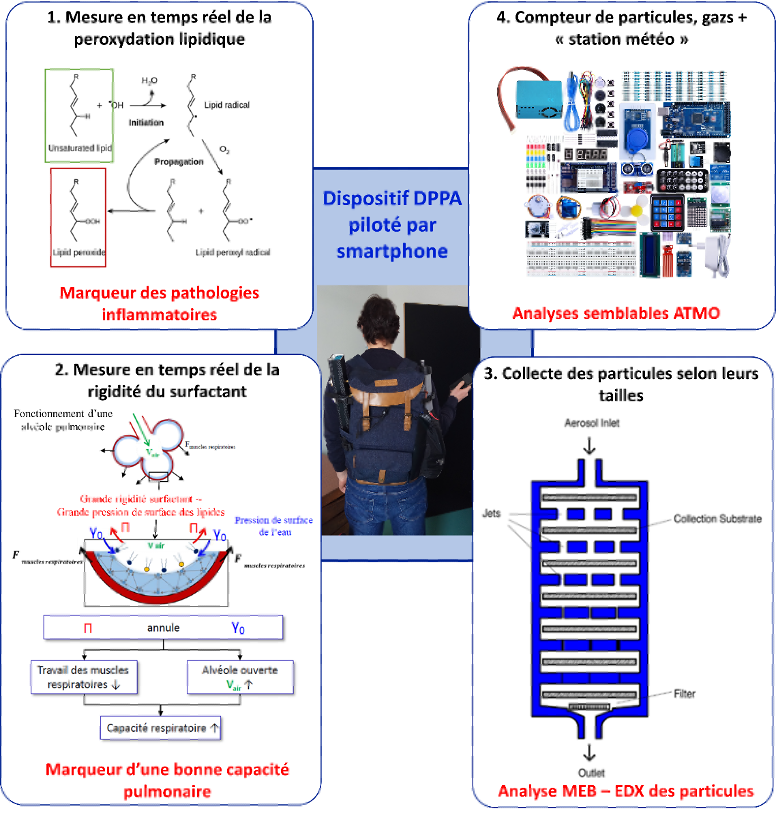
-
Bio-tribometer
Simulator for simultaneous compression, shear and rolling loading of biological tissues, soft materials simulating biological tissues or joint implants (adaptable to the configuration of a unicompartmental knee prosthesis or hemi prosthesis of the shoulder). or joint implants (adaptable to simulate unicompartmental knee prosthesis or shoulder hemi prosthesis). This bio-tribometer has been designed to enable high-resolution study of the mechanisms of bio-lubrication by lipid multilayers lipid multilayers (https://anr.fr/Project-ANR-12-BS04-0008). It is currently compatible with confocal fluorescence microscopy and cell cultures.
Technical specifications :- Maximum normal load: 300N
- Horizontal movement: maximum stroke 12mm, maximum frequency 100 Hz
- Long vertical travel: maximum stroke 30mm, low speed (qq mm/s)
- Small vertical movement: maximum stroke 80µm, maximum frequency 100Hz
- Rotational movement: low speed (qq mm / s depending on configuration); maximum torque 30 N*m
- Possibility of synchronising movements according to a predefined curve (gait cycle)
- Several types of sensor for dynamic measurement of forces, torques and displacements along the three axes
- Possibility of adapting specific electrochemical cells (team collaboration) CORRIS MATEIS)
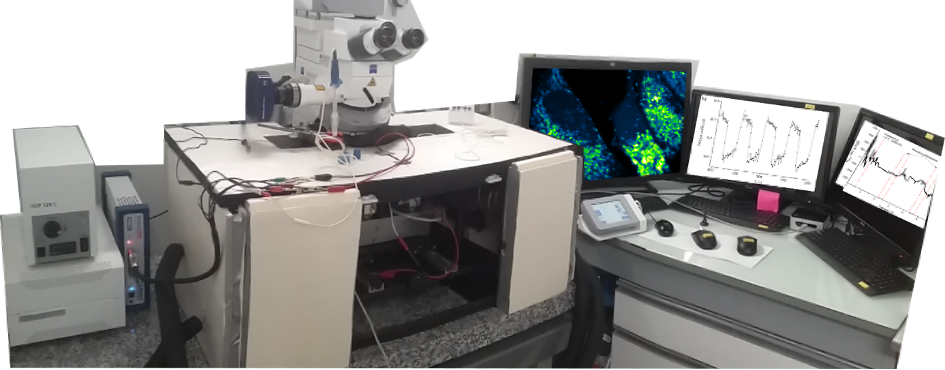
-
Bio-triboreactor
Simulator for simultaneously compressing and shearing 3 'cell culture' samples, The samples are immersed in a closed-circuit circulation of nutrient liquid, the flow rate of which is regulated by a peristaltic pump.
The 2 stresses may be coupled or independent.
-
Compression :
- Dz = 0 to 870µ with an accuracy of 50nm,
- Frequency from 0 to 100 Hz, sine, triangle.
-
Shear :
- Dt = 0 to 870µ with an accuracy of 50 (rotation of approximately +/- 2° over a radius of 20 mm)
- Frequency from 0 to 100 Hz, sine, triangle.
-
Applicable forces and moments :
- Fz max applicable = 200 N, sensitivity 'in place': 0.001N, accuracy 0.01N
- Mz max applicable= 0.4 N.m, sensitivity 'in place': 0.001 N.m, accuracy 0.01 N.m.
-
Operating conditions:
- Cedrat PID closed-loop motion control, 50nm accuracy.
- Software with synchronisation of Fz/Dz and Mz/Dt measurements, autonomous for several months to enable rheological characterisation in normal configuration and to monitor the development of in-situ cultures.
- Enclosure compatible with cell cultures and confocal fluorescence microscope

-
Compression :
- Working with platforms
